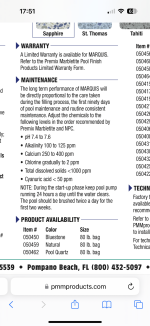Good luck with your brand new being-built pool.
- When it's filled, most people here would recommend that you test your pool chemistry yourself
- (and most would recommend you use a good pool-math calculator on your mobile device)
- Most would also recommend you use only liquid chlorine (no tablets, no granules, no powders) for sanitization
- (keep your cyanuric acid level as low as feasible, where around 30 ppm is a good inflection point to aim for)
- (maintain free chlorine at least 7.5% higher than the CYA, and then plus 1 or 2 ppm)
- (maintain free chlorine at less than 7.5% of your CYA - e.g., half that - only if your phosphates are extremely low)
- (this eclectic algae assessment is rarely discussed but it came from either Richard Falk or Bob Lowry, as I recall)
- Maintain the water's calcium saturation equilibrium within +/- 0.33 of the zero crossing point
- (generally that means aim for calcium saturation & carbonate alkalinity to be within typical ranges)]
- (not many people know this, but a common ratio is 1:4 alkalinity ppm to calcium ppm)
- (keep in mind you have little control over the temperature & not much control over the pH and/or TDS)
If you don't fully understand any of those basics, don't worry as everyone here knows them inside & out (so you can read up on each of them & ask away if necessary).


